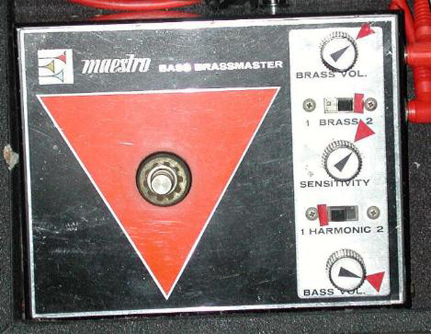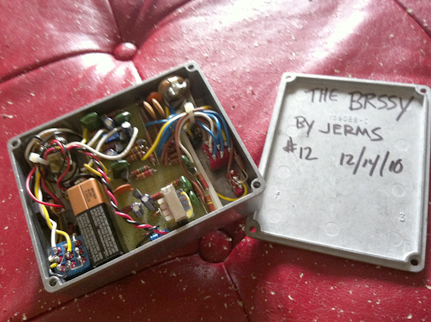Jerms Brssy (Brassmaster clone)

My first guitarnerd pedal review… the Jerms Brssy.
My obsession with guitars is pretty much all consuming. I think about them every day, and this obsession has rewarded me with playing music in an awesome band, touring Europe a few times and best of all, meeting my wife. While I love guitars, guitar pedals haven’t drawn me into their web as much. I think this is due to a few factors… 1. My blue Marshall sounds (sounded… it’s STILL broken) so damn good that I never needed any pedals to get the sound I needed, and 2. The pedals I did have got stolen out of my garage in 1997 and that put me off collecting them. I stuck with my blue Marshall and remained blissfully unaware of the guitar pedal world.
Through meeting Tim from Tym Guitars and designing the art for his guitar pedals, I’ve grown to acknowledge guitar pedals actually exist and yeah… they are pretty addictive. I’m still not at the point where I lust after an original 70’s Ram Head Big Muff, though. I still feel all I need is my white face Rat to get most of the sounds I need… but I’m getting there.
Apart from owning a few Tym pedals, I also have been acquiring a few hand made pedals built by friends which I will talk about in future guitarnerd stories. I like the idea of a hand built pedal… the low build numbers etc. One of my favourites is a Super Fuzz FY6 pedal built by my friend Mike. It’s a monster. Well… while surfing eBay, I found this pedal which was for sale in Brisbane.

It’s a clone of a Brassmaster, which is the bass version of the Super Fuzz, made by Maestro.

The price was really good, and best of all it was built by Jim Roth from Built To Spill, who goes under the name ‘Jerms’ for his pedals. His pedals are very sought after as he only builds a few, so I treated myself to a Christmas present and snapped it up.
It looks VERY well made. As I’ve said, I’m not an expert but this thing is really tidy inside.

Jim also signs the back plate, which is a nice touch. My Brssy is #12 and was built on the 14th of December 2010, which funnily enough was almost a year to the day when I got it.

Anyway, I’d been wanting to start doing stories on pedals in guitarnerd for a while, but honestly, as I’m not really an expert I thought I needed to do a pedal review MY way. Most pedal reviews are in depth and the reviewers talk about capacitors and resistors and all that other black magic that goes into making pedals sound like pedals. I thought the best way would be to have a pure example of what these things sound like in action.
Of course, this has been done before… check out YouTube. Most of these pedal reviews consist of someone setting up their handy-cam or iphone in front of their amp and them wailing away. Then they upload it and YouTube compresses the absolute sh!t out of the audio & video. What you end up with is an audio sample that sounds like you’re listening to it through an empty toilet roll.
Then I thought of a way that might work… plug the pedal DIRECTLY into my MacBook and record it using Garageband. Then upload it using Sound Cloud. That way the sound is as pure and high quality as I can get it. Hopefully you’ll agree.

I used my Mustang Bass fitted with Seymour Duncan P-Bass pickups, as that’s my ‘play at home’ bass and also my G&L SC3 which I’ve recently re-fallen in love with.

This pedal is known for it’s doom-tastic distortion… so I thought it’d be best to show you how it sounds by recording a short doom tune. Both the bass & guitar tracks are through the Brssy, and into a pristine clean Garageband Vox amp sound, as that way you’ll hear what this pedal sounds like the best. I added a little delay to the guitar track to make it sound more doom-tastic and doom-thentic. Oh, and I dropped the low E down to B, which is my favourite new tuning. I got this tuning from Mastodon and it’s fantastic.
First up though, I play a track with the bass alone along with a drum loop. To show what the ‘filter’ and ‘harm’ switches do, I played the riff with both of them off… then the filter on and harm off… then filter off and harm on… then both filter and harm on. It’s best listened to with headphones.

The filter switch basically cuts a lot of the bass and balls from the sound… I’m not a fan of this switch. The harm adds some treble and I don’t know… hifi-ness (I told you… I’m NOT a pedal expert!) and I really like this switch. Both on and the filter switch kind of spoils everything.
Next up I did a track with both bass & guitar so you can hear how this pedal would work in a band situation. I started the track with the bass by itself so you could hear what it sounds like before I add the guitar. Also, the guitar is through the neck pickup, as this sounded more doomy, and would be how I would play this pedal. The SC3’s single coils are ballsy and don’t turn to mush, not like a neck humbucker would. Anyway, enough explaining… here’s the track. Again, it’s best listened to with headphones.
As you can see (or hear), the pedal nails that doom sound pretty hard. The bass distortion kind of compresses on itself when you hit the note, then blooms and you can hear all the fuzzy goodness inside when the note starts dying. It works well for bass and guitar, but I noticed with guitar that there isn’t much sustain… when the note dies, it kind of does that cool bitcrush effect which the Ampeg Scrambler is famous for.
So… there’s my first guitarnerd pedal review. I hope you liked it. Let me know what you think and I’ll be adding more pedal stories in the future.

Awesome stuff Tony! Could you bring it in for me to have a play thru sometime???